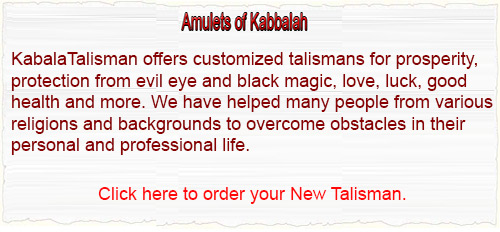Kabbalah Magic Amulets
 Rabbi David Azulai
Rabbi David Azulai
Amulets Types, Kabbalah - Kabbalistic, Kabbalah Amulets Comments Off on Kabbalah Magic Amulets
Kabbalah, the ancient Jewish mystical tradition, has fascinated people throughout history with its profound insights into the divine, the universe, and the human soul. A particularly intriguing aspect of Kabbalah is its use of amulets—objects believed to possess magical powers that can protect, heal, and bring good fortune. These amulets, deeply embedded in Kabbalistic tradition, are imbued with mystical symbols, sacred texts, and divine names.
The history of Kabbalistic amulets stretches back to ancient times. While the use of amulets is common across various cultures and religions, Kabbalistic amulets are unique in their integration of Hebrew letters, divine names, and other elements from Jewish mysticism. These amulets are typically crafted by knowledgeable practitioners who inscribe them with specific formulas and prayers to invoke divine protection and blessings.
Central to Kabbalah is the belief in the power of words and letters. Hebrew is considered a sacred language, with each letter carrying its own spiritual significance and vibrational energy. Kabbalists believe that arranging these letters in particular ways allows them to tap into divine forces and influence the material world. This belief forms the foundation for creating Kabbalistic amulets, where combinations of letters, names, and symbols are carefully selected to achieve a desired effect.
There are various types of Kabbalistic amulets, each serving a distinct purpose. Some are designed to protect against evil spirits and negative energies, while others aim to attract prosperity, health, or love. The specific symbols and inscriptions used on an amulet depend on its intended purpose. For example, a common protective amulet might feature the names of angels or the Tetragrammaton (the four-letter name of God) to ward off harm.
One well-known Kabbalistic amulet is the “Mezuzah.” Traditionally affixed to the doorposts of Jewish homes, the Mezuzah contains a parchment inscribed with specific Hebrew verses from the Torah. It serves as a reminder of God’s presence and offers protection to those who dwell in the home. Although the Mezuzah is widely recognized as a Jewish ritual object, its origins are deeply intertwined with Kabbalistic traditions.
Another widely recognized Kabbalistic amulet is the “Hamsa,” also known as the Hand of Miriam or Hand of Fatima. This amulet, shaped like an open hand, is believed to protect against the evil eye and bring good fortune. The Hamsa often features an eye symbol in the center, representing divine watchfulness and protection. In Kabbalistic tradition, the Hamsa is sometimes inscribed with prayers or sacred names to enhance its protective power.
Kabbalistic amulets are not just physical objects; they are deeply connected to the spiritual practices and beliefs of those who create and use them. The process of making an amulet involves ritual purification, meditation, and prayer. The practitioner must be in a state of spiritual purity and concentration to imbue the amulet with the desired energy. This aspect of amulet-making highlights the importance of intention and faith in Kabbalistic practices.
In addition to their protective and beneficial uses, Kabbalistic amulets also serve as tools for personal transformation and spiritual growth. By carrying or wearing an amulet, individuals are reminded of their connection to the divine and encouraged to align their actions with their spiritual values. The amulet serves as a concrete symbol of their faith and dedication to their spiritual journey.
The use of Kabbalistic amulets has persisted through the centuries, adapting to different cultural contexts and evolving with the times. Today, these amulets continue to be popular among those who seek spiritual protection, guidance, and blessings. They are often used in conjunction with other Kabbalistic practices, such as meditation, prayer, and the study of sacred texts.
The creation and use of Kabbalistic amulets also reflect the broader principles of Kabbalah, which emphasize the interconnectedness of all things and the presence of divine energy in every aspect of life. By recognizing and harnessing this divine energy, practitioners believe they can influence their own lives and the world around them.
In modern times, Kabbalistic amulets have found a place in popular culture, often being embraced by celebrities and individuals seeking spiritual insight and protection. This renewed interest has brought greater visibility to Kabbalistic traditions and has sparked curiosity about the deeper meanings and practices associated with these ancient symbols.
Despite their popularity, it is important to approach Kabbalistic amulets with respect and understanding. They are not mere trinkets or superstitious objects, but rather powerful symbols rooted in a rich spiritual tradition. Genuine Kabbalistic amulets are created with deep knowledge, intention, and reverence for the mystical teachings of Kabbalah.
To truly appreciate the significance of Kabbalistic amulets, one must delve into the study of Kabbalah itself. This mystical tradition offers profound insights into the nature of the divine, the structure of the universe, and the path to spiritual enlightenment. Through the study and practice of Kabbalah, individuals can deepen their understanding of these ancient symbols and harness their transformative power.
In conclusion, Kabbalistic amulets are fascinating objects that embody the mystical teachings of Kabbalah. They serve as tools for protection, healing, and spiritual growth, reflecting the deep belief in the power of words, letters, and divine energy. By understanding and respecting the traditions behind these amulets, individuals can connect with the ancient wisdom of Kabbalah and invite its blessings into their lives. Whether used for personal protection or as part of a broader spiritual practice, Kabbalistic amulets continue to inspire and guide those who seek to connect with the divine.
admin @ December 9, 2009
Order Protection Talisman Now

